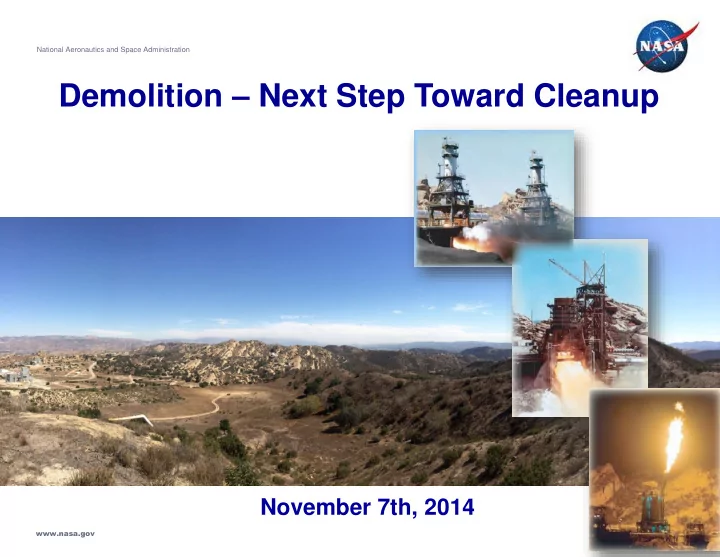

National Aeronautics and Space Administration Demolition – Next Step Toward Cleanup November 7th, 2014 www.nasa.gov
Safety Overview National Aeronautics and Space Administration 2
Biological Hazards Rattlesnakes Spiders Black Widow Ants Brown Recluse Bees/Wasps Mountain Lions Mosquitoes Coyotes Ticks Poison Oak Scorpions
Biological Hazards: Hiding Spots
Physical Hazards: Abandoned Buildings
Weapons, Drugs, Alcohol, and Tobacco Firearms and knives are prohibited at SSFL Possession or consumption of drugs or alcohol at SSFL is prohibited Use of tobacco products (cigars, cigarettes, chewing tobacco, etc.) is prohibited at SSFL Use of e-cigarettes is prohibited at SSFL
Work Dress Working at or visiting NASA/SSFL requires minimum work dress unless in a tour van or on paved roadways away from equipment. Work shoes Sturdy, slip resistant, closed toe Not dress or athletic shoes unless ANSI approved safety shoes Long pants Hard hats required when working around test stands Snake gaiters required when working off pavement Other PPE may be needed depending on the area to be visited and the work to be done ANSI = American National Standards Institute PPE = Personal Protective Equipment
Sun Burn Wear a good pair of sunglasses and some kind of protection on your head. If you are among those likely to burn, use a sunblock with an SPF of 15 or greater. An ounce of sunblock will effectively cover your entire body. Apply sunblock at least 15 to 30 minutes before venturing out into the sun. Reapply every two hours, especially if you have been perspiring. Use sunblocks with higher SPF on areas that need extra protection like your nose, ears, and shoulders.
Heat Stress Drink water and stay hydrated Weather is usually dry at SSFL and hydration is essential Begin drinking water before field work Monitor other personnel for signs of heat stress
Asbestos Notification Notification per California Health and Safety Code Chapter 10.4 Asbestos-containing construction materials (ACCM) are known to be present in all Area II structures (buildings and test stands) at SSFL Asbestos is a known human carcinogen and a lung disease hazard. Cal/OSHA defines ACCM as material containing 0.1% asbestos by weight. When intact and in good condition ACCM fibers do not release into the air. Can be released if cut, drilled into, damaged or disturbed. ACCM materials include but are not limited to floor tile, mastic, linoleum and backing, drywall, joint compound, plaster surfacing material, ceiling tile, acoustical spray material, fireproofing, thermal insulation, boiler insulation duct work, building tar, wall sealant, window putty, cement wall siding, cement piping, electrical components and wiring, brake systems, fire doors, gaskets, and joints Presence of ACCM des not imply or indicate a health risk or danger of being overexposed to asbestos while onsite. NASA policy prohibits disturbing, touching, cutting, modifying or altering building materials that contain asbestos. Results of ACCM surveys available from NASA upon request
SSFL Map National Aeronautics and Space Administration 11
National Aeronautics and Space Administration NASA Operational History at SSFL Rocket Engine Testing Got Us to the Moon • NASA administers roughly 451 acres of federal property • Four rocket engine test areas: Alfa, Bravo, Coca, Delta • Over 17,000 rocket engine and component tests conducted • Last engine test occurred at Alfa in 2006 • No more active operations and test stands are obsolete National Aeronautics and Space Administration 12
Supporting NASA’s Space Programs Alan Shepard John Glenn Neil Armstrong John Young John Glenn Feb 20, 1962 Mike Collins Bob Crippen Oct 29, 1998 May 5, 1961 Buzz Aldrin Apr 12, 1981 Jul 16, 1969 Redstone Atlas F-1 J-2 SSME Basic SSME Block IIA National Aeronautics and Space Administration 13
NASA Activities at SSFL (2014 Forward ) Today’s work at SSFL is focused on 3 projects: 1. Demolition 2. Soil Cleanup 3. Groundwater Cleanup Photos of soil Sampling, bedrock vapor extraction treatability study, drilling, soil sampling evaluation, COE demolition (generic) National Aeronautics and Space Administration 14
Demolition Areas for Initial Phase Yellow highlighted areas are the first phase of demolition National Aeronautics and Space Administration 15
Demolition Overview Important next step towards cleanup • Executing work through US Army Corps of Engineers • Demolition planned in phases • Demolition begins November 2014 Service Area Delta Test Area • Coca Test Area demolition scheduled late 2015 • Goal is to save one test stand (Alfa or Bravo area) NASA SSFL EIS – Mar 27, 2012 National Aeronautics and Space Administration 16
National Historic Preservation Act (NHPA) • NHPA Section 106 consultation resulted in protective and historic recordation actions • Preserve Test Stand Deferral and plan to preserve at least one test stand and associated control house Laser recordation, curation of artifacts, and photo-documentation • Protection of Sacred Site Use of monitors and archeologists, and additional studies as a result of the PA and Native American consultations National Aeronautics and Space Administration 17
NASA SSFL EIS – Mar 27, 2012 National Aeronautics and Space Administration 18
Recommend
More recommend